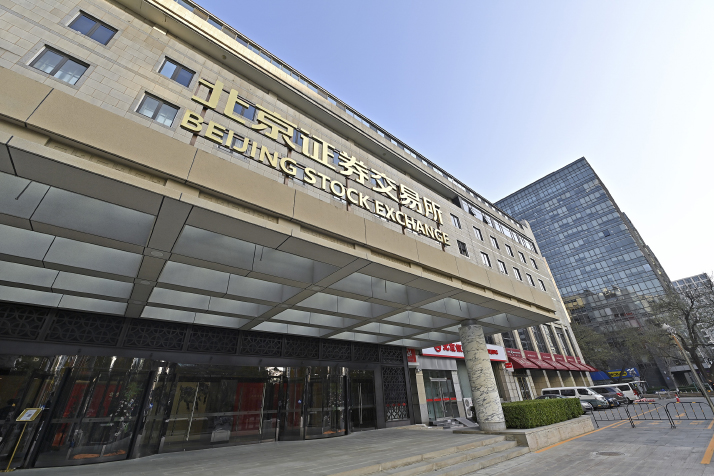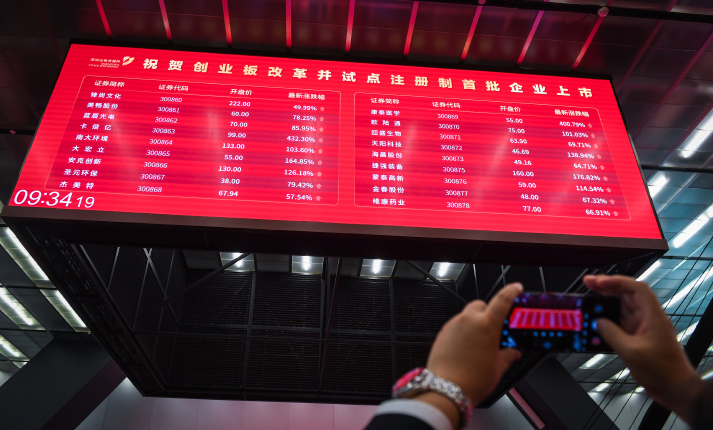
ThundeRobot, a gaming device company based in Qingdao, Shandong Province, became the first company in the gaming sector to be listed on the Beijing Stock Exchange (BSE) on December 23, 2022. The BSE, designed as a major financing platform for small and medium-sized enterprises (SMEs), especially innovation-driven ones, began trading in November 2021. As of December 23 last year, 156 firms had offered their stocks on the BSE.
According to the China Securities Regulatory Commission (CSRC), the number of companies listed on the country's A-share market exceeded 5,000 as of the end of 2022, up over 30 percent compared with 2019.
Chinese A-shares are the shares of incorporated companies based in the Chinese mainland that are listed on the stock exchanges in Shanghai, Shenzhen in Guangdong Province and Beijing. In addition to their main boards, the Shanghai Stock Exchange also features the Nasdaq-style sci-tech innovation board, known as the STAR market, while the Shenzhen Stock Exchange's ChiNext board mainly serves growth firms and startups. A-shares are mainly available for trading to Chinese mainland investors, but foreign investment in the companies is allowed under regulation.
"China's capital market has seen notable expansion, which is expected to further back up development of the real economy. Facing COVID-19 impacts, high-quality listed companies have been playing a leading role in driving China's economic recovery," Dong Dengxin, Director of the Finance and Securities Institute at Wuhan University of Science and Technology, told Beijing Review.
Boom in storm
Total operating revenue of listed companies on the A-share market reached 52.37 trillion yuan ($7.8 trillion) in the first three quarters of 2022, up 8.51 percent year on year, data from China Association for Public Companies (CAPCO) showed.
Li Ming, an official with the CSRC, told the Annual Conference of the Financial Street Forum in Beijing in November 2022, where participants discussed China's financial reform and development, the structure of the listed companies has been improved in recent years. Companies are larger and more profitable, with more balanced financing channels, and more listed companies are from emerging industries, Li added.
Profits of listed non-financial companies surpassed those of listed financial ones, accounting for 57.3 percent of the total, according to the CSRC.
"Around 486 companies were listed on the STAR market, which raised more than 730 billion yuan ($108.8 billion) in initial public offerings (IPOs). Their total market value exceeded 6 trillion yuan ($894 billion)," Cai Jianchun, General Manager of the Shanghai Stock Exchange, said at the Financial Street Forum conference.
According to the Shenzhen Stock Exchange, there were more than 1,200 companies listed on the ChiNext board as of November 2022, with a total market value of over 11 trillion yuan ($1.6 trillion).
In November 2014, the Shanghai-Hong Kong Stock Connect program was launched, giving mainland and international investors direct access to each other's market for the first time. It was followed by the Shenzhen-Hong Kong Stock Connect program in December 2016.
Over the past year, funds flying through the Shenzhen-Hong Kong Stock Connect program to China's largest wind turbine manufacturer Xinjiang Goldwind Science and Technology Co. Ltd. exceeded 100 million Hong Kong dollars ($12.8 million).
Goldwind went public on the main board of the Shenzhen Stock Exchange in 2007. China has announced that it will peak carbon dioxide emissions before 2030 and achieve carbon neutrality before 2060, which brings great opportunities for this company.
As of the end of September 2022, Goldwind had a global installed capacity of more than 92 gigawatt. Its products are sold across 38 countries, with the total number of wind turbines reaching over 46,000 across the globe, the company said.

Better market
While encouraging the growth of companies, China's securities regulator has been improving the delisting system to promote sound development of the stock market.
Shanghai and Shenzhen stock exchanges on December 31, 2020, released revised delisting rules for companies listed on their main boards, the STAR market and the ChiNext board. The revisions allow trading indicators such as stock prices and market values to play a greater role, and pin more emphasis to operation sustainability of listed companies, the CSRC said.
The CSRC said the number of delisted companies reached 42 in 2022. Since 2021, 59 firms have exited the A-share market, accounting for 40 percent of the total number of delisted companies over the past three decades.
In 2023, the number of delisted companies in China is expected to exceed 50. The system will help squeeze out malperforming companies from the market, according to Dong. Once junk stocks are removed, the market environment will turn better with high-quality companies becoming the majority, he added.
"It will still take time to improve the quality of listed companies in China. Public firms need to overcome internal and external challenges to create growth in 2023," Song Zhiping, President of CAPCO, told China Listed Companies Forum, taking place in Jinjiang, Fujian Province, on December 30, 2022.
In December 2022, the CSRC said it will advance the registration-based IPO system reform for efficient resource allocation. The reform, launched in 2019 to replace the approval-based regime, aims to ease enterprises' burdens and increase transparency with an open and paperless application review process.
The commission unveiled priorities including enhancing the structure of listed companies, improving market environment and making the regulatory system more full-fledged in the next three years. It also pledged efforts to improve rules and regulations, enhance governance and strengthen supervision on listed companies.
There is much room for expanding China's capital market, according to Dong. He called on the authorities to further reform the registration-based IPO system, which has been adopted by the BSE and ChiNext and STAR markets. The number of companies listed on the BSE is likely to reach 5,000 in the next few years, he said.
"The BSE should distinguish itself from Shanghai and Shenzhen stock exchanges, and provide more inclusive and flexible systems to support the growth of SMEs," Dong concluded.
As China is optimizing its COVID-19 response measures, its social and economic activities are back to normal and foreign financial institutions are becoming more bullish about China's stock market in 2023.
New York-headquartered investment company Morgan Stanley upgraded its outlook for 2023 China stocks in early January from equal-weight to overweight. As it projected, the Chinese stock market is likely to stand out among those of global economies this year.
According to the 23rd UBS Greater China Conference, held by Swiss bank UBS on January 9, the slowdown in Chinese stock valuations in 2022 could be attributed to low investor confidence caused by COVID-19 and a cooling property market. But the adverse factors will fade away this year. China is expected to see a 4.9-percent GDP growth in 2023, according to UBS.
(Print Edition Title: Thriving in Headwinds)
Copyedited by G.P. Wilson
Comments to lixiaoyang@cicgamericas.com